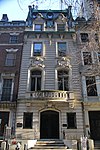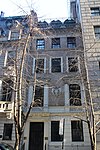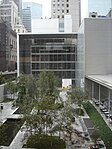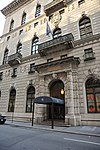11 West 54th Street

11 West 54th Street (also 9 West 54th Street and the James J. Goodwin Residence) is a commercial building in the Midtown Manhattan neighborhood of New York City. It is along 54th Street's northern sidewalk between Fifth Avenue and Sixth Avenue. The four-and-a-half-story building was designed by McKim, Mead & White in the Georgian Revival style and was constructed between 1896 and 1898 as a private residence. It is one of five consecutive townhouses erected along the same city block during the 1890s, the others being 5, 7, 13 and 15 West 54th Street. The building is designed as a double house, with a larger unit at 11 West 54th Street to the west, as well as a smaller unit at 9 West 54th Street to the east. The facade is made of rusticated blocks of limestone on the first story, as well as Flemish bond brick on the upper stories. Businessman James Junius Goodwin and his wife Josephine lived at the main unit at number 11 with his family and rented number 9. The house initially served as the second residence for James Goodwin, who lived primarily in Connecticut. James Goodwin died in 1915, and Josephine continued to live in the house until 1939, after which it was used briefly by the Inter-America House and the Museum of Modern Art The house was sold to Parsonage Point Realty Company in 1944 and leased to the Rhodes Preparatory School, which bought the building in 1949. The house was then sold in 1979 to the United States Trust Company, which renovated the structure. The New York City Landmarks Preservation Commission designated the house as an official landmark in 1981, and it was added to the National Register of Historic Places in 1990 as part of the 5–15 West 54th Street Residences historic district.
Excerpt from the Wikipedia article 11 West 54th Street (License: CC BY-SA 3.0, Authors, Images).11 West 54th Street
West 54th Street, New York Manhattan
Geographical coordinates (GPS) Address Nearby Places Show on map
Geographical coordinates (GPS)
| Latitude | Longitude |
|---|---|
| N 40.7616 ° | E -73.9762 ° |
Address
Lehman Art House
West 54th Street 7
10019 New York, Manhattan
New York, United States
Open on Google Maps









